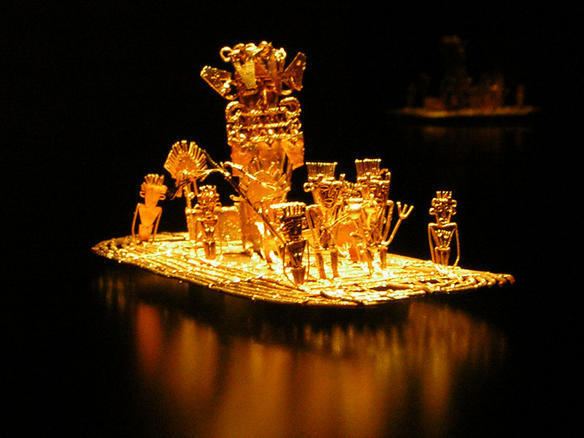 | ||
The Muisca cuisine describes the food and preparation the Muisca elaborated. The Muisca were an advanced civilization inhabiting the central highlands of the Colombian Andes (Altiplano Cundiboyacense) before the Spanish conquest of the Muisca in the 1530s. Their diet and cuisine consisted of many endemic flora and fauna of Colombia. Main product of the Muisca was maize, in various forms. The advantage of maize was that it could be grown in the various climatic zones the Muisca territories experienced. It was the basis for their diet and the alcoholic drink, chicha, made from fermented maize and sugar. In the Muisca religion their agriculture and celebration of harvests, conducted along the complex Muisca calendar, were protected by Chaquén and Nencatacoa. The Muisca ate a variety of roots and tubers and even had a specific word in their Chibcha language for eating those: bgysqua.
Contents
Muisca cuisine
The Muisca cultivated many different crops in their own regions, part of the Muisca Confederation, and obtained more exotic culinary treats through trade with neighbouring indigenous peoples, with as most important; the Lache (cotton, tobacco, tropical fruits, sea snails), Muzo (emeralds, Magdalena River fish, access to gold, spices), Achagua (coca, feathers, yopó, Llanos Basin fish, curare). The climatic variation of the Muisca territories allowed for the agriculture of different crops. Javier Ocampo López describes the Muisca diet as predominantly vegetarian: potatoes, maize, beans, mandioca, tomatoes, calabazas, peppers and numerous fruits. The Muisca also used grains known today as quinoa. Main base for the Muisca cuisine was maize, considered a holy crop. The Muisca roasted corn (maize), ate it off the plant or converted it into popcorn. Main meat was the guinea pig, endemic to South America, which they farmed in their homes. In special cases they ate llamas, alpacas, deer, capybara (chigüiro in Spanish), and fish from the rivers and lakes of the Altiplano Cundiboyacense and Magdalena and Llanos through trade. The Muisca drank a lot of chicha, a fermented alcoholic drink of maize and sugar, served in ceramic pots called urdu or aryballus.
Paleodietary studies performed on the Bogotá savanna, where 18 Muisca skeletons ranging in historical age from 8th to 10th century AD and 26 skeletons from the 12th and 13th century AD, together with analysis of 10 mummies of the Guane, Lache and Muisca were analysed, have shown that about 60% of the food of the people consisted of vegetary products and 40% of meat and especially fish.
After the Spanish conquest, the access to meat was drastically reduced changing the diet of the Muisca and other indigenous groups of central Colombia. Studies from Tunja, called Hunza in the time of the Muisca, have shown the people did not suffer from malnutrition though.
Words for maize
As maize was the most important crop and food for the Muisca, their language (Muysccubun) had many different words for maize, parts of the plant and the different processes and eating habits.
Note: for the pronunciation, it helps to think Spanish; "j" refers to hard "g"-sound, not the soft English "j/y"
Plants
The Muisca cultivated their crops in so-called camellones, artificially elevated surfaces that allowed the roots of the crops to be sufficiently irrigated with the -on average 700-1000 mm of- rain in a year and drainage systems regulating the water levels.
Main plants to be cultivated were:
Grains and cereals
Fruits
Leaves
Mammals
Birds
As Colombia has the biggest biodiversity of birds in the world, they formed part of their cuisine, mainly:
Fish
Insects
Food processing and preparation
Using the abundant coal of the Muisca territories, they heated their ovens and cooked their food.
Eating habits
The Muisca sat down on the ground while eating and they didn't use cutlery, yet ate with their hands. The food was served on leaves or in their ceramic pots.
